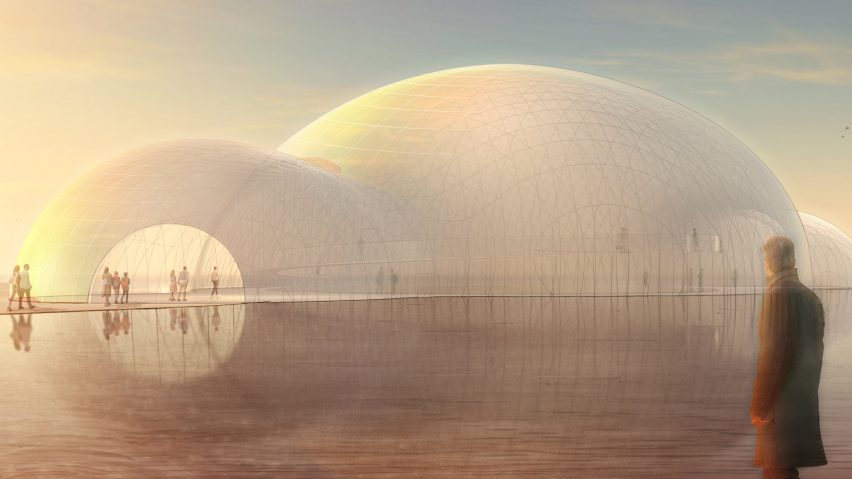
Shigeru Ban unveils triple-domed Expo 2025 Osaka pavilion
Japanese architect Shigeru Ban has given Dezeen an exclusive look at his design for the Expo 2025 Osaka, an undulating pavilion that will be built from paper tubes, bamboo and carbon-fibre reinforced plastic.
The Blue Ocean Dome pavilion, pictured above, has a sinuous shape with a large domed central pavilion flanked by two smaller domes. It will be located on reclaimed land in Yumeshima, Osaka, where the World Expo 2025 will be held.
The triple domes will be constructed using three materials, including the paper tube system that Ban has previously used to create shelters for earthquake victims as well as a thatched-roof restaurant in Japan.
Pavilion to be built partly from paper tubes
"For the Osaka Expo 2025, I'm using three different materials for my pavilion," Ban told Dezeen at the launch of an installation designed by the architect in Milan.
"The first one is the paper tube, the new kind – the joint system with wood – and the second one is laminated bamboo."
The reason for using laminated bamboo was to meet Japan's building regulations, Ban explained.
"Natural bamboo is not very easy to use to meet the current building regulation as the size is all different, and the bamboo is very weak to sun exposure."
"So in countries that have very strong building regulations we cannot use natural bamboo as a building material, including in Japan," he added.
"However, if we laminate the bamboo, we can control the quality, strength and durability. So in the pavilion, I'm using laminated bamboo as a structure in a very unusual way."
The third material to be used for the 1,925 square-metre undulating pavilion is carbon-fibre reinforced plastic, which is not normally used for buildings as it is expensive.
However, Ban chose to use it for his World Expo pavilion as it meant he could avoid using concrete piles, which he would have otherwise had to use due to the soil conditions of the site.
"This time the expo is held on reclaimed land," he said. "So although it is just a temporary building, because the soil is very weak, we would have to put in lots of concrete piles."
"After the half-year Expo we would have to remove them – it's a lot of work to make a temporary building, it's very expensive, and we'd have to waste concrete piles after it's been removed," he added.
"I made my building using carbon-reinforced plastic which weighs less than the soil we removed for the foundation, which means we don't need any concrete piles. The construction period also becomes shorter, so this is really a new way of using carbon fibre for the building industry."
Ban to "develop a system for future building" at Expo
The Expo should be an occasion for architects to try to experiment with these new kinds of structures, Ban believes.
"In recent pavilions, any country, they're just competing with different unusual shapes, not being innovative on the structure," he said.
"I'm hoping to develop a system for future building, not competing with unusual shapes."
Ban's pavilion was designed for a non-profit organisation called Zero Emissions Research and Initiatives (ZERI).
Inside, it will house an exhibition focusing on "the importance of the ocean and its life, and how our ocean is being polluted by human waste such as plastic," a spokesperson for Shigeru Ban Architects said.
The Expo 2025 Osaka is a World Expo – a global exhibition that takes part every five years. It will be held in Osaka from 13 April to 13 October 2025.
The logo for the exhibition, an irregular ring of red circles that represents the shape of the city, was unveiled in 2020.
The latest World Expo, Expo 2020 Dubai, was held in 2021 after being postponed due to the coronavirus pandemic. It featured pavilions by world-renowned studios including Santiago Calatrava and Foster + Partners. The entrances to the expo were marked with a trio of entry portals made from carbon fibre that were designed by British architect Asif Khan.